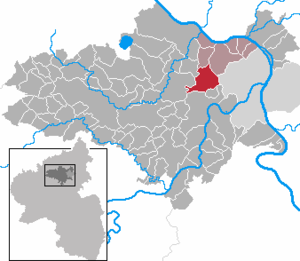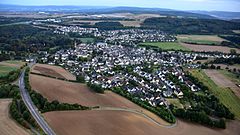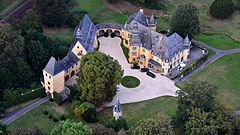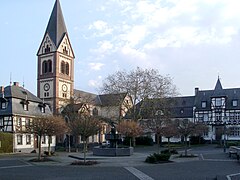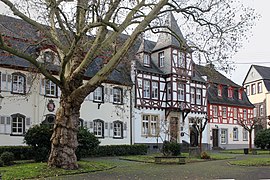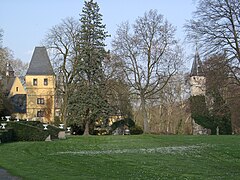Bassenheim
| coat of arms | Germany map | |
|---|---|---|

|
Coordinates: 50 ° 22 ′ N , 7 ° 28 ′ E |
|
| Basic data | ||
| State : | Rhineland-Palatinate | |
| County : | Mayen-Koblenz | |
| Association municipality : | Weißenthurm | |
| Height : | 205 m above sea level NHN | |
| Area : | 14.76 km 2 | |
| Residents: | 2845 (Dec. 31, 2019) | |
| Population density : | 193 inhabitants per km 2 | |
| Postal code : | 56220 | |
| Area code : | 02625 | |
| License plate : | MYK, MY | |
| Community key : | 07 1 37 202 | |
| LOCODE : | DE USE | |
| Association administration address: | Kärlicher Strasse 4 56575 Weißenthurm |
|
| Website : | ||
| Mayoress : | Natalja Kronenberg ( CDU ) | |
| Location of the local community of Bassenheim in the Mayen-Koblenz district | ||
Bassenheim is a municipality in the Mayen-Koblenz district in Rhineland-Palatinate , about 10 km from Koblenz . It belongs to the community of Weißenthurm .
climate
The annual precipitation is 646 mm. The precipitation is in the lower third of the values recorded in Germany. Lower values are registered at 30% of the measuring stations of the German Weather Service . The driest month is February, with the most rainfall in July. In July there is 1.8 times more rainfall than in February. The rainfall is distributed fairly evenly over the year. Lower seasonal fluctuations are recorded at 33% of the measuring stations .
history
Archaeological finds such as clay vessels, shards of vessels and a so-called firebock indicate that there was a settlement in the area of today's Bassenheim as early as in Celtic times or around 500 BC. Remains of buildings discovered in 1885 are likely of Roman origin.
13th to 19th centuries
According to a document from 1265 , the rule of Bassenheim was initially a fiefdom of Kurköln in the Middle Ages . Later it came into the possession of the Counts of Wied , who enfeoffed the Counts of Isenburg-Braunsberg with it in 1373. Their after-fiefs, in turn, were the Waldbott von Waldmannshausen aristocratic family, whose ancestral castle was near Hadamar. The family, which later called themselves Waldbott von Bassenheim , gradually brought the entire rule into their sole possession through purchase and inheritance and finally gained imperial directness in 1729 . In the Peace of Lunéville in 1801 it lost its holdings on the left bank of the Rhine to France , but was compensated in 1803 by the Reichsdeputationshauptschluss . Until 1815 Bassenheim belonged to the French Department de Rhin-et-Moselle and was the seat of the Mairie of the same name . This comprised the adjacent Kurtrierische Bergpflege office and corresponded roughly to the present day community of Weißenthurm . After the end of the Napoleonic Wars , Bassenheim, like the entire Rhineland, fell to Prussia . As a now mediatized class lords , the count family got their property back in Bassenheim.
Time of the von Oppenheim family
As a result of the bankruptcy of Count Hugo Waldbott von Bassenheim , their local castle and the associated manor were foreclosed in 1861. Prince Karl Anton von Hohenzollern bought the property for about 465,000 thalers and sold it in 1873 to Abraham Freiherr von Oppenheim (1804–1878) and his wife Charlotte. Lively construction activity began among them in Bassenheim. Among other things, they had the Bassenheim Castle expanded and restored. The architect was Julius Carl Raschdorff , who was considered the most important master builder in Cologne at the time. Seven years after the death of Abraham von Oppenheim, his widow donated the Bassenheim hospital to the community and provided it with 400,000 marks for maintenance . In 1977 the hospital was closed and in 1984 after renovation and expansion it was converted into a therapy center for the psychosomatically ill . Other buildings from Oppenheim's time are the Rentamt on today's Walpotplatz, the Marstall on Mayener Strasse, the “Alte Apotheke” and the “Haus am See”, which once housed steam engines that generated the pressure for the water supply. Many private houses were also built through the sale of building sites to citizens of Bassenheim. Abraham and Charlotte von Oppenheim died childless. In 1910 the castle and manor of Bassenheim were sold to Julius von Waldthausen . His heirs had the castle demolished in 1937 because of excessive maintenance costs.
Adenauer and Schuman meet in Bassenheim
Bassenheim Castle, which still exists today, was the seat of the governor of the Trier and Koblenz administrative districts and later state commissioner of Rhineland-Palatinate, Claude Hettier de Boislambert , at the time of the French occupation after World War II . On October 8, 1948, there was a meeting between the French Foreign Minister Robert Schuman and the future German Chancellor Konrad Adenauer . The meeting was secret and only became known when Adenauer published his "Memoirs" in 1965. The encounter is seen as a starting point for the reconciliation between France and Germany.
politics
Bassenheim is a municipality in the Mayen-Koblenz district in Rhineland-Palatinate , about 10 km from Koblenz . It belongs to the community of Weißenthurm .
Municipal council
The municipal council in Bassenheim consists of 20 council members, who were elected in the local elections on May 26, 2019 in a personalized proportional representation, and the honorary local mayor as chairman.
The distribution of seats in the municipal council:
| choice | SPD | CDU | total |
|---|---|---|---|
| 2019 | 6th | 14th | 20 seats |
| 2014 | 7th | 13 | 20 seats |
| 2009 | 7th | 13 | 20 seats |
| 2004 | 7th | 13 | 20 seats |
mayor
The local mayor of Bassenheim is Natalja Kronenberg (CDU). In the direct election on May 26, 2019, she was elected with a share of the vote of 75.29%, making her successor to Arno Schmitz (CDU).
coat of arms
| Blazon : "Twelve frames of silver and red, covered with a large red heart shield, inside a golden orb in perspective." | |
| Justification of the coat of arms: The coat of arms of the municipality of Bassenheim is based on historical facts in such a way that it shows a large red heart shield on the shield of the forest bot, which is made of silver and red and which stands out as the edge of the shield, in which there is a golden orb as a symbol of imperial immediacy . The local colors are red and white corresponding to those of the Waldbott family. |
The award of the coat of arms to the municipality of Bassenheim was pronounced on February 18, 1936 with a certificate from the Upper President of the Rhine Province .
Twin cities
- Pasym , Poland
- We have been on friendly terms with today's Pasym, the former East Prussian Passenheim, since 1988. But the historical relationships are much older: The village of Heinrichswalde, founded by the Teutonic Order, received city rights in 1386. The first city of Masuria was given the name "Bassenheim" in honor of the highest Spittler and Commander of the Teutonic Order, Siegfried Walpot von Bassenheim. The East Prussians made it "Passenheim", the Poles called it "Pasym" as early as the 19th century. It is now officially called and still bears the coat of arms introduced by Siegfried Walpot von Bassenheim today. Pasym is located between the large Kalbensee and Lelskersee, 30 km southeast of Allenstein (Olsztyn), has a huge area (around 15,000 hectares) and 5000 inhabitants, 2500 of whom live in the city, the others in rural areas.
- Pougues-les-Eaux , France
- Pougues-les-Eaux, 11 km from the Koblenz twin town Nevers / Loire, was already known for its thermal springs in the 16th century. The city was a seaside resort until 1971. In the former park area there is now a casino that attracts many visitors. The city has 2500 inhabitants. The partnership relationships have arisen since 1989 from friendly connections between the tennis clubs in both places; they were officially decided in 1994. The friendship group Bassenheim / Pougues-les-Eaux has existed since September 1st, 1993.
Therapy center Bassenheim
After Abraham Oppenheim's death in 1885, Charlotte Oppenheim founded the “Von-Oppenheim'sche Hospital”. To build it, she donated the building site, an additional 5000 m² of land and 400,000 marks to the community. The hospital, which was expanded to include a kindergarten and a sewing school in 1888, was intended to provide medical care for the poor, the infirm and the sick. After it was closed in 1977, the building was restored and expanded and reopened in 1984 as the “Bassenheim Therapy Center” for the psychosomatically ill.
Culture and sights
- The most famous work of art in Bassenheim is the Bassenheimer Reiter in the parish church of St. Martin . The early Gothic relief of St. Martin , which is ascribed to the Naumburg master , comes from the western part of the Mainz Cathedral and was brought to Bassenheim by the Mainz canon Casimir Waldbott von Bassenheim in 1683.
- Bassenheim Castle had been owned by the Archbishops of Trier since the 13th century, and later became the seat of ministerials . The rule of Bassenheim fell before 1300 through the marriage of Helena von Bachem, heir to the knight Heinrich von Bachem, with Siegfried Walpod († 1333) to the family of Waldbott von Bassenheim . In 1729 the rule of Bassenheim (became a fiefdom of Kurköln due to the decline of the County of Sayn ) became part of the empire and was directly subordinate to the emperor. Count Hugo Waldbott lost the 600-year-old headquarters in 1862 through a foreclosure auction. The castle and estate are now owned by the Barons von Waldthausen - Osten . The castle is not open to the public.
- In Bassenheim, part of the Jewish cemetery was preserved despite the devastation of Nazi rule.
- The historical fountain by the Kottenheim sculptor Paul Milles from 1985 stands on the Walpotplatz, later supplemented by statues of the knights and counts of Bassenheim.
- The Martinus Museum has been set up in house number 3 on Walpot Square. It is a baroque building from 1753, made of lava scum, but lightly plastered and with painted red corner blocks. The early messenger of the parish of St. Martin once lived in the house and from 1813 to 1840 the first general Bassenheim school was set up in it. From 1895 to 1995 it was the town hall and since the completion of the renovation in 2002 and 2003 it has been a museum. This museum is dedicated to St. Martin and his picture, the Bassenheimer Reiter. There is also information about the knights and barons of Bassenheim.
- Since June 2012, an accessible memorial made up of twelve steles has been commemorating the meeting between Robert Schuman and Konrad Adenauer in the Bassenheimer Burg, with which the reconciliation between France and Germany began in 1948. The creator of the monument is Harald Stieding, the main initiators were the former mayor of Bassenheim, Theobald Groß, Cord Michael Sander and Josef Seul.
- In the vicinity of the village are the Karmelenberg , a cinder cone of volcanic origin, with the Marienkapelle built in 1662 and the Goloring .
See also: List of cultural monuments in Bassenheim
Personalities
- Siegfried Walpot von Bassenheim , Komtur and highest Spittler of the medieval Teutonic Order state in the Baltic States . In 1386 the first town of Masuria was named Bassenheim (later Passenheim ) in his honor . Today's Polish Pasym is Bassenheim's twin town.
Grew up in Bassenheim
- Christian Nicolay (* 1976), athlete, 2006 German javelin champion
- Jens Tiedtke (1979–2019), athlete, national handball player
- Rolf Weiber (* 1957), economist, professor for general business administration
- Karl-Josef Häfner (* 1952), Mayor of the Kelberg / Vulkaneifel municipality
Associated with Bassenheim
- Julius Raschdorff (1823–1914), architect
- Charlotte Oppenheim (1811-1887)
- Helene von Nostitz (1878–1944), writer; Niece of the later Reich President Paul von Hindenburg ; died in Bassenheim
- Claude Hettier de Boislambert (1906–1986), military governor of Rhineland, then Rhineland-Palatinate from 1945 to 1951, resided in Bassenheim Castle
- Theobald Groß (1929–2019), journalist, book author, former mayor of Bassenheim and honorary citizen
traffic
The Bassenheim station was on the Koblenz-Lützel-Mayen Ost railway line . Passenger traffic ended on December 9, 1983.
literature
- Josef Bartz: Bassenheim stories of a community. Self-published, Bassenheim 2007 (stories of the community over the past 100 years).
- Theobald Groß: A gem between the Rhine and Eifel. Impressions from the historic Bassenheim. Self-published, Bassenheim 2004 (home book of the former mayor).
- Hans-Eckhart Joachim: The Iron Age barrow field of Bassenheim . Ed .: Landschaftsverband Rheinland (= Rheinische Ausgrabungen . Volume 35 ). Rheinland-Verlag, Cologne 1990, ISBN 3-7927-1136-2 .
- Bernhard Gondorf: Bassenheim near Koblenz . 1st edition. Neusser Druckerei und Verlag, Neuss 1984, ISBN 3-88094-477-6 .
- Peter Schug, Jakob Marx, Matthias Schuler: History of the deaneries Bassenheim, Kaisersesch, Kobern and Münstermaifeld (= history of the parishes of the Diocese of Trier . Volume 7 ). Trier 1966, DNB 456737499 .
- Karl-Heinrich Reif, Hermann Müller: Family book Bassenheim for the period from the 16th to the 18th century .
- Eleonora Heine-Jundi : Dream whispers in an avenue . Alleon-Verlag, Bassenheim 2003, ISBN 3-00-011116-6 .
- Jane in der Beek: The daughters of Herr von Bassenheim . Kelter, Hamburg 1969, DNB 456047352 .
Web links
- The official website of the local community of Bassenheim
- History of the organs in Bassenheim. (PDF; 47 kB) (No longer available online.) Archived from the original on March 21, 2017 .
- Literature about Bassenheim in the Rhineland-Palatinate State Bibliography
Individual evidence
- ↑ State Statistical Office of Rhineland-Palatinate - population status 2019, districts, communities, association communities ( help on this ).
- ^ A b c Hans Erich Kubach, Fritz Michel , Hermann Schnitzler: The art monuments of the district of Koblenz . Pedagogical Verlag Schwann, Düsseldorf 1944. (Reprint 1981, ISBN 3-590-32142-3 )
- ^ Gerhard Köbler : Historical Lexicon of the German Lands. The German territories and imperial immediate families from the Middle Ages to the present. 6th, completely revised edition, CH Beck, Munich 1999, ISBN 3-406-44333-8 , p. 41 u.
- ↑ a b Theobald Groß: Gem between the Rhine and Eifel . Walter printer, Bassenheim 2004.
- ^ The Regional Returning Officer Rhineland-Palatinate: Local elections 2019, city and municipal council elections. Retrieved October 28, 2019 .
- ^ The Regional Returning Officer Rhineland-Palatinate: direct elections 2019. see Weißenthurm, Verbandsgemeinde, first line of results. Retrieved November 10, 2019 .
- ↑ Homepage of the community of Bassenheim, accessed on July 13, 2010 ( Memento from July 28, 2011 in the Internet Archive )
- ↑ a b Jewish history / family "of Oppenheim" in Bassenheim (Kreis Mayen-Koblenz) . Alemannia-judaica.de. Retrieved June 18, 2010.
- ^ Chronicle of Bassenheim ( Memento of February 6, 2006 in the Internet Archive )
- ^ Theobald Groß: Gem between the Rhine and Eifel - Impressions from the historic Bassenheim . Bassenheim 2004, pp. 138-140.
- ^ Theobald Groß: Gem between the Rhine and Eifel - Impressions from the historic Bassenheim . Bassenheim 2004.
- ↑ Winfried Scholz: Reconciliation began in Bassenheim . In: Rhein-Zeitung Koblenz from June 18, 2012, p. 15.

